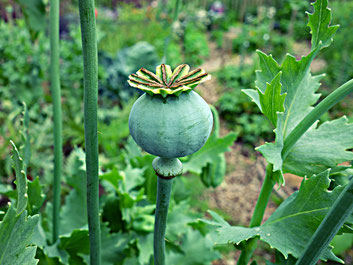
There was a time in my reading career when I devoured every regency romance I could get my hands on. Georgette Heyer is still among my favorite authors. For the longest time, I read about ladies clutching their smelling salts in one hand, and a bottle of laudanum in the other, without ever realizing just what that harmless-seeming potion really was: A tincture made from the juices (latex) gained from unripe breadseed poppy (Papaver somniferum) seeds.
I may have been the only person in the world who hadn't known that, but I was fairly astonished to find out that laudanum is nothing other than opium, desolved in strong
alcohol. No wonder those high-strung imaginary ladies slept like the dead after taking a dose of their little potion!
Opium latex contains a high percentage of morphine, a highly addictive analgesic (pain killer) which acts directly on the central nervous system. It lowers blood pressure and makes the user drowsy as a side effect.
Opium also works against diarrhea, and has a depressant effect on the respiratory system. It is sometimes prescribed as a cough suppressor. An overdose can completely paralyze the lungs, though, so it must be used with extreme caution.

In the absence of other, less dangerous analgetics, a conscientious doctor of the regency era might have prescribed laudanum to relieve a severely injured patient's pain, or maybe even to alleviate a strong migraine, as well as to treat severe diarrhea. Taking the drug against a slight headache or to facilitate sleep, however, is nothing other than drug abuse, pure and simple.
Author Courtney Milan, in her novel "Once Upon a Marquess", clearly shows us this dangerous aspect of the much-cited remedy. Her protagonist Christian wakes from a nightmare to find his loving but overprotective mother by his bedside, offering a posset just like she'd always done when he was still a nightmare-haunted little boy:
"You were dreaming," she repeated. "It was just another night terror, Christian. I made you a little posset."
He could taste the milk and the spices and the honey on his tongue. He could taste the laudanum, too. Bitter, ugly, and yet after all these years, it still curled around him, whispering that he could have peace. It would be the peace of utter surrender.
"No," he said hoarsely. "No possets."
Laudanum was discovered in the 16th century by the Swiss-German alchemist Paracelsus, who found that the pain-blocking alkaloids (morphine and codeine, among others) contained in breadseed poppy seeds are soluble in alcohol. He called his alcoholic opium tincture laudanum, possibly as a combination of the Latin words laudare (to praise), and labdanum (a resin from rockrose scrubs, which at the time was used to treat coughs, menstrual problems and rheumatism).
Opium tincture, in combination with various other pain-reducing substances, until the end of the 19th century was used as a remedy for a wide variety of symptoms. In the early years of the 20th
century, the first efforts at regulating highly addictive drugs were made, and today opium is only used rarely. To this day, though, the drug is sometimes prescribed for severe diarrhea, and
its high content of morphine still makes it a potent - if dangerous - analgesic.
*** Please note: This blog is not intended as medical advice. ***
Do not try this at home.
(Or at least, don't use any of the remedies described here this without consulting your physician first.)
